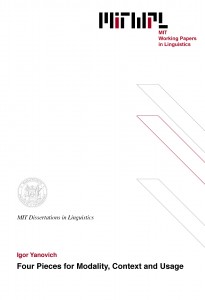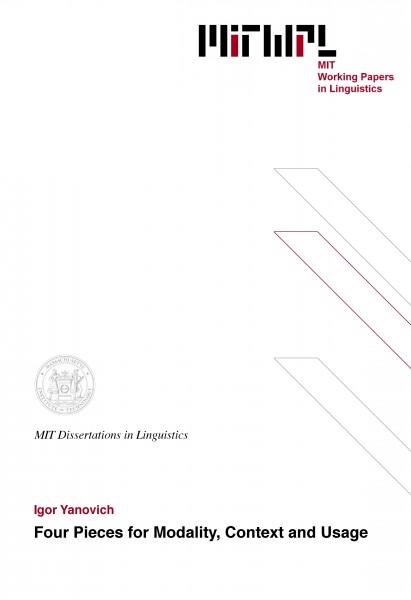Four Pieces for Modality, Context and Usage
Igor Yanovich, 2013
The main part of this dissertation consists of four loosely connected chapters on the semantics of modals. The chapters inform each other and employ similar methods, but generally each one is self-contained and can be read in isolation. Chapter 2 introduces new semantics for epistemic modality. I argue that the epistemic modal base consists of the propositions that can be obtained by the interlocutors early enough to affect their resolution of their current practical goal. Integrated into the standard contextualist semantics, the new definition successfully accounts for two sets of data that have been claimed to falsify standard contextualism, namely from disagreement dialogues and complements of attitude verbs.
Chapter 3 traces the historical rise of the may-under-hope construction, as in I hope we may succeed. In that construction, the modal does not contribute its normal existential modal force. It turns out that despite the construction’s archaic flavor in Present-Day English, it is a very recent innovation that arose not earlier than the 16th century. I put forward a hypothesis that the may-under-hope construction arose as the replacement of an earlier construction where the inflectional subjunctive under verbs of hoping was used to mark a specific type of formal hopes about good health.
Chapter 4 proposes that O(ld) E(nglish) *motan, the ancestor of Modern English must, was a variable-force modal somewhat similar to the variable-force modals of the American Pacific Northwest. I argue that in Alfredian OE, motan(p) presupposed that if p gets a chance to actualize, it will. I also argue that several centuries later, in the ‘AB’ dialect, Early Middle English *moten is was genuinely ambiguous between possibility and necessity. Thus a new trajectory of semantic change is discovered: variable force, to ambiguity between possibility and necessity, to regular necessity.
Chapter 5 argues that, first, restrictions on the relative scope of deontics and clausemate negation can hardly be all captured within the syntactic component, and second, that cap- turing some of them can be due to semantic filters on representations. I support the second claim by showing how such semantic filters on scope may arise historically, using Russian stoit ‘should’ and English have to as examples.

